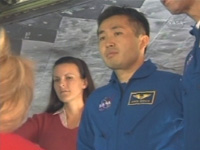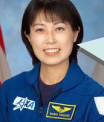JAXA Astronaut Activity Report, November 2008
Last Updated: January 21, 2009
This is JAXA's Japanese astronaut primary activity report for November 2008.
Astronaut Yamazaki assigned to Space Shuttle mission
On November 11, 2008, Astronaut Yamazaki was assigned as a crew member for the STS-131 (19A) Mission. She is now scheduled to fly aboard the space shuttle on the STS-131 (19A) Mission, which is planned no earlier than (NET) February 2010.
The STS-131 Mission will deliver a Multi-Purpose Logistics Module (MPLM) that carries large amounts of supplies to the International Space Station (ISS). Astronaut Yamazaki participated in a press conference held at JAXA's Tokyo Headquarters and expressed her ambitions, "It has been one of my goals to take part in the ISS assembly mission, so I am very pleased to be selected. I am looking forward to working together with many colleagues toward the mission success."
Training for JEMRMS and Rehearsal for H-II Transfer Vehicle (HTV) Training

Astronaut Hoshide (back) operating the robotic arm simulator to simulate relocation of the ICS-EF
Astronauts Hoshide and Yamazaki participated in training on the robotic operation of the Japanese Experiment Module Remote Manipulator System (JEMRMS) at the Tsukuba Space Center (TKSC).

Astronauts Hoshide (back) and Yamazaki (front) operating the robotic arm simulator during a rehearsal for a HTV training session.
During the training, they simulated installing the Inter-orbit Communication System Exposed Facility (ICS-EF) that will be installed on Kibo's Exposed Facility (EF) during the STS-127 (2J/A) Mission. Both the ELM-ES and the EF will be delivered to the ISS on the STS-127 (2J/A) Mission.
They also participated in a rehearsal of the H-II Transfer Vehicle (HTV) training. During the rehearsal, they played roles as trainee astronauts and simulated the robotic operations using the JEMRMS simulator. They simulated grappling the Exposed Pallet (EP), which was assumed to be removed from the HTV by the Space Station Remote Manipulator System (SSRMS) and handed over to the JEMRMS, and installing the EP on the EF. They also simulated relocating a payload attached to the EP onto the EF. In the future, astronauts from many different countries will participate in this training.
- 2J/A Mission
Columbus Training at ESA

Astronauts Wakata (right) and Noguchi (left) during training on operating the glovebox in the Biolab (©DLR)

Astronauts Wakata (back) and Noguchi (right) during training on FSL operation (©DLR)
Astronauts Wakata and Noguchi participated in training on ESA's Columbus module at the European Astronaut Centre of the European Space Agency (ESA) in Germany.
This training was designed for the astronauts assigned to the ISS expedition missions to acquire required knowledge and skills for operating equipment on board Columbus.
During the training, the two astronauts learned operations of the glovebox in the Biolab, experiments housed in the Fluid Science Laboratory (FSL) and European Physiology Modules (EPM), and instruments on the European Drawer Rack (EDR) that measures the change of spatial awareness, or instruments that monitor protein crystallization. They also participated in the training to learn about the thermal control system, data management system, electrical power system, and environmental control and life support system of the Columbus laboratory.
At the end of the training session, astronauts Wakata and Noguchi went through a simulation training using the mockup of Columbus and were certified as Columbus Specialists who have knowledge and skills required for Columbus operations.
ISS Expedition Operations Training in Russia

Astronaut Wakata during training on the life support system inside the Zvezda trainer (©JAXA/GCTC)

Astronaut Noguchi demonstrating Russian space food, a survival kit stored on board the Soyuz TMA spacecraft, and the Mir Space Station (©JAXA/GCTC)
Astronauts Wakata and Noguchi participated in training at the Gagarin Cosmonaut Training Center (GCTC) in Russia in preparation for the ISS expeditions.
Astronaut Wakata participated in training sessions on the command and control computers and the life support system of the Russian modules of the ISS, and the attitude control system and life support system of Soyuz TMA spacecraft.
Astronaut Noguchi participated in the training on the Soyuz TMA spacecraft including its structure and layout, the attitude control system and the thermal control system, and the main computer of the Russian modules. He also participated in training on manual rendezvous and docking of Soyuz spacecraft to the ISS.
During the training period, the training site was open to the media, and astronaut Noguchi introduced training facilities, the Soyuz TMA spacecraft, and Russian spacesuits and space food. Also, astronauts Wakata and Noguchi participated in a press conference and expressed enthusiasm for the ISS expeditions.
Crew Equipment Interface Test (CEIT) for STS-119 Mission

Astronaut Wakata checking Discovery (Image credit: NASA)
Astronaut Wakata participated in the Crew Equipment Interface Test (CEIT) for the STS-119 Mission along with the other STS-119 crew members. He will fly to the ISS on the STS-119 (15A) Mission and join the Expedition 18 crew.
During the CEIT, the assigned crew members have the opportunity to verify the usability of the equipment that they will actually be using during their mission.
Astronaut Wakata and his STS-119 crewmates checked out the space shuttle Discovery they will fly aboard and the S6 truss that will be brought up in the payload bay of Discovery.
Operations Training for SSRMS and CBM

Astronaut Furukawa operating the SSRMS simulator
Astronaut Furukawa participated in training at NASA Johnson Space Center (JSC) on operating the SSRMS, and the Common Berthing Mechanism (CBM), one of the berthing mechanisms connecting ISS modules, in preparation for the ISS expedition.
During the SSRMS training, he operated the SSRMS simulator to simulate grappling the HTV. For the CBM operations, he learned troubleshooting procedures for system anomalies.
Official Flight Kits (OFKs) of the STS-124 Mission Returned

Return of Meikei Gakuen’s school flag (From left: Principal Mr. Shibata of Meikei Gakuen and Astronaut Hoshide)

Return of a rugby jersey (From right: President Yoshiro Mori of Japan Rugby Football Union, Astronaut Hoshide, and General Manager Osamu Ota of the Japan National Rugby Team)(©2008,JRFU)
Astronaut Hoshide visited Meikei Gakuen Junior and Senior High School in Ibaraki Prefecture where he graduated, and returned the Official Flight Kits (OFKs) flown in space during the STS-124 Mission.
The OFKs contain requested items selected from different organizations that the flight crew members are associated with. They are flown aboard the space shuttles, and after their flights, the items are returned to the providing organization. A school flag of Meikei Gakuen Junior and Senior High School was selected and flown aboard the space shuttle as the OFK.
Astronaut Hoshide returned the OFK and gave a lecture as well. He introduced the STS-124 Mission and his experience in space showing pictures and video of the mission. Students asked him a lot of questions such as, “When I am working toward a goal and have a setback, how can I bounce back from it?” He answered the question saying, “I was depressed when I failed the selection for astronauts twice, but I pulled myself together for the next selection. I think it is important to move on by refreshing your mind,” bringing cheers from the students.
Astronaut Hoshide also visited the Chichibunomiya Rugby Field in Tokyo to return the rugby jersey of the Japan National Team flown aboard the space shuttle as an OFK to the Japan Rugby Football Union.
- 1J Mission
"The 34th JAXA Town Meeting" in Matsuyama

Town meeting
Astronaut Doi attended "The 34th JAXA Town Meeting" in Matsuyama, Ehime Prefecture, with JAXA President Dr. Tachikawa, and exchanged views with the participants on Japan's space development and human space activity.
An active discussion included topics of development of human space flight by other countries and international cooperation, as well as questions about astronauts and their life in space. Astronaut Doi expressed his view on Japan’s future development of human space flight and said that Japan should have its own manned spacecraft.












